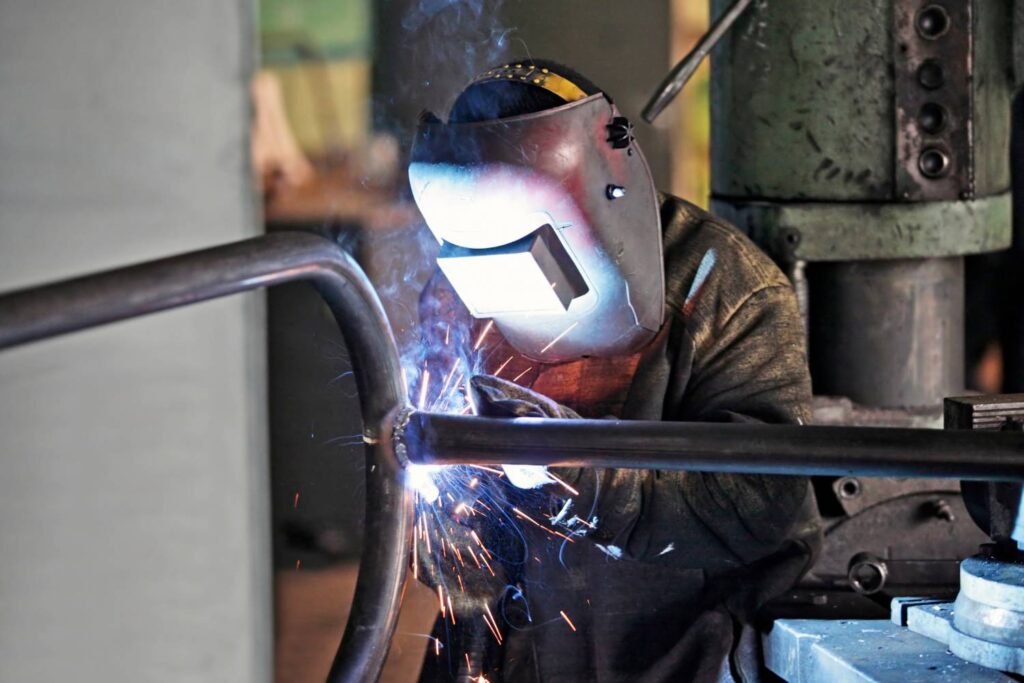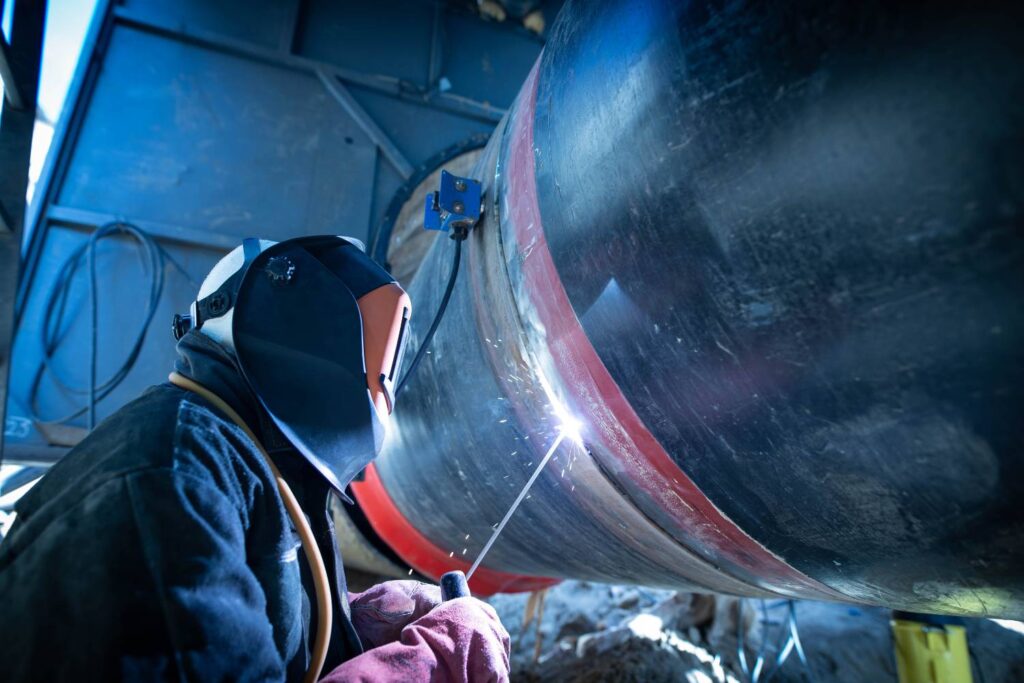Welding, a process that might seem straightforward to the uninitiated, is a cornerstone of modern construction, manufacturing, and even art.
At its core, welding is about joining materials, typically metals or thermoplastics, by applying heat, pressure, or a combination of both. But to view welding merely as a method of sticking two pieces together is to overlook the depth of skill, science, and significance behind this essential technique.
Table of Contents
Learning About Welding
Welding is a cornerstone in the fabrication world, a process that has evolved over centuries to become integral to countless industries.
From constructing skyscrapers and bridges to manufacturing automobiles and spacecraft, welding techniques and technologies have developed to meet diverse needs, ensuring strength, durability, and efficiency in every weld. This exploration into welding reveals its principles, various processes, and the advancements that have shaped its current state.

The Essence Of Welding
At its core, welding is a fabrication method where two or more parts are fused through heat, pressure, or a combination of both, resulting in a joint as the parts cool. This process is primarily applied to metals and thermoplastics, with the resulting joint often more robust than the parent materials. The versatility of welding allows it to be used not just on metals but also on thermoplastics and, in some innovative applications, wood.
Welding Processes Demystified
Welding encompasses a variety of processes, each suited to specific applications based on the materials being welded, the desired strength of the weld, and the environment in which welding takes place. Some of the most common welding processes include:
- Arc Welding: Utilises an electrical arc to melt workpieces and a filler material to join them. Subtypes include Shielded Metal Arc Welding (SMAW), Gas Tungsten Arc Welding (GTAW/TIG), and Gas Metal Arc Welding (GMAW/MIG).
- MIG/MAG Welding: Known for its versatility and speed, MIG (Metal Inert Gas) and MAG (Metal Active Gas) welding use a continuously fed wire electrode and shielding gas to protect the weld pool from contamination.
- TIG Welding: Offers high-quality, precise welds for thinner gauge materials. TIG (Tungsten Inert Gas) welding uses a non-consumable tungsten electrode, often used where weld appearance is critical.
- Resistance Welding: A process that generates heat through the material's resistance to electric current flow, commonly used in manufacturing processes for joining sheet metal.
- Friction Welding: Utilises mechanical friction to heat materials, joining them in a solid state. This method is beneficial for joining dissimilar materials.
Innovations And Safety In Welding
The field of welding continues to advance with innovations aimed at improving efficiency, quality, and safety. Modern welding equipment includes features that simplify setting adjustments, ensure consistent quality, and enhance the safety of the welding process. Safety remains paramount, with protective gear and proper ventilation crucial to protect welders from hazards such as ultraviolet radiation, sparks, and toxic fumes.
Welding In Design And Fabrication
Understanding welding is essential for designing metal components and assemblies. The choice of welding process can significantly affect the final product's strength, appearance, and cost. Design considerations must account for the weldability of materials, the stresses the welds will endure, and the aesthetic requirements of the finished piece.
The Future Of Welding
As technology progresses, so does the field of welding, with ongoing research into more efficient, cleaner, and more versatile welding methods. Integrating digital technologies, automation, and robotics in welding processes promises to revolutionise welding, making it faster, safer, and more accessible.
With its rich history and critical role in historical and modern fabrication, welding remains a fascinating and ever-evolving discipline. Its importance in constructing the world around us— from the cars we drive to the buildings we inhabit—cannot be overstated, making the understanding of welding processes and principles essential for engineers, designers, and fabricators.
The Science Behind Welding
Welding, a process integral to constructing everything from skyscrapers to spacecraft, is as much an art as a science. It's a method refined over centuries, evolving alongside materials science and technology advancements. At its heart, welding involves coalescing materials, typically metals, by applying heat, pressure, or both. However, the science behind welding encompasses a broad spectrum of physics, chemistry, and metallurgy, each contributing to the weld's strength, durability, and efficiency.
Reasons Behind Welding.
The Metallurgical Foundation
Welding metallurgy, the branch of metallurgical engineering that deals with the effects of welding on materials forms the scientific backbone of welding processes. It examines how different metals behave under various welding conditions, including the thermal cycles they undergo and the resultant microstructural changes.
This understanding is crucial for predicting and controlling the mechanical properties of the weld, ensuring it meets the required specifications for its intended application.
The Role Of Electricity In Welding
Arc welding, one of the most common methods, utilises an electrical arc to heat the base materials and any filler metal. The arc is created between an electrode and the workpiece, melting the metals at the point of contact to form a pool of molten material that, upon cooling, becomes a robust and unified joint.
This process is underpinned by fundamental principles of electricity, including voltage, current, and resistance, each playing a role in forming and maintaining the welding arc.
Heat, Pressure, And State Changes
Applying heat from an electric arc, a gas flame, or another source is fundamental to welding. This heat causes the metal to undergo a phase change from solid to liquid, allowing the materials to fuse. In some welding processes, pressure is also applied (either with or without heat) to facilitate the bonding of the materials. The science behind these state changes and controlling the cooling process is critical for achieving a weld with the desired mechanical and physical properties.
Advances In Welding Science
Recent advancements in welding science, particularly in laser welding and electron beam welding, highlight the ongoing evolution of the discipline. These technologies offer greater precision and control, enabling welding materials previously considered challenging or impossible to weld. Moreover, the development of new filler materials, including those designed for specific properties like corrosion resistance or high strength, further expands the capabilities of welding.
Environmental And Safety Considerations
The science of welding also encompasses environmental and safety considerations. The generation of fumes and gases, the risk of electric shock, and the potential for fires and explosions are all aspects that welding science seeks to mitigate by developing
safer welding practices and equipment. This includes using ventilation systems, protective gear, and the formulation of welding processes that minimise hazardous emissions.
Advances In Welding Technology
The welding industry is currently undergoing a transformative phase, marked by significant technological advancements that promise to redefine traditional welding practices. These innovations enhance the efficiency and quality of welding and address environmental concerns and the need for skilled labour. Let's delve into some of the most notable advancements in welding technology, drawing insights from recent developments across the sector.
Automation And Digitalisation
The integration of automation in welding processes has been a game-changer. Robotic welding systems and welding cobots (collaborative robots) are now at the forefront, designed to work alongside human welders rather than replace them.
These systems offer flexibility, allowing for easy programming and adjustments to accommodate various welding tasks with minimal changeover time. The result significantly boosts productivity, consistency, and safety, reducing the potential for human error and workplace accidents.
Digitalisation in welding has brought about the digital collection and analysis of welding data, enabling precise control over welding parameters.
This leads to smoother welds and allows for predictive maintenance, identifying potential issues before they lead to downtime. Using digital tools and software in designing, planning, and simulating welding projects has also significantly improved the accuracy and efficiency of welding operations.
Laser Welding And Hybrid Techniques
Laser welding stands out for its precision and the ability to join complex and dissimilar materials with minimal distortion. This technology benefits industries requiring high-quality welds, such as aerospace, medical equipment manufacturing, and jewellery production. Hybrid welding techniques, which combine laser welding with traditional processes, offer the best of both worlds—speed and penetration of arc welding combined with the precision of laser welding.
Green Welding Technologies
Sustainability is becoming increasingly important in the welding industry, with a growing emphasis on green technologies. These technologies aim to reduce the environmental impact of welding by minimising energy consumption and emissions. Innovations in this area include the development of more energy-efficient welding machines, the use of environmentally friendly materials, and processes that produce less waste.

Skills And Training For The Future
As welding technology advances, so does the need for skilled professionals who can navigate these new tools and methods. For welders to stay abreast of the latest trends and innovations, continuous learning and training are essential. Technical institutes and welding schools now offer programs covering advanced welding technologies, including automation, digitalisation, and green welding practices.
Industry 4.0 And Welding
The welding industry is not immune to the influences of Industry 4.0, with intelligent manufacturing principles being applied to welding processes. Network-linked production systems enable the seamless integration of design, production, quality control, and maintenance activities. This connectivity allows for real-time monitoring and control, further enhancing the efficiency and quality of welding operations.
Conclusion
Welding is a crucial process in modern construction, manufacturing, and art, involving the joining materials through heat, pressure, or a combination of both. It is primarily applied to metals and thermoplastics, with the resulting joint often more robust than the parent materials. Welding processes are diverse and suited to specific applications, such as Arc Welding, MIG/MAG Welding, TIG Welding, Resistance Welding, and Friction Welding.
Innovations and safety in welding are ongoing, with modern welding equipment enhancing efficiency, quality, and safety. Design considerations must consider the weldability of materials, the stresses they will endure, and the aesthetic requirements of the finished piece. As technology advances, the welding field evolves, with ongoing research into more efficient, cleaner, and versatile methods.
The metallurgical foundation of welding is the branch of metallurgical engineering that deals with the effects of welding on materials. This understanding is crucial for predicting and controlling the mechanical properties of the weld, ensuring it meets the required specifications for its intended application. Integrating digital technologies, automation, and robotics in welding processes promises to revolutionise welding further, making it faster, safer, and more accessible.
Welding is a fundamental process that uses electricity to melt base materials and filler metals, creating a pool of molten material that forms a robust and unified joint upon cooling. Applying heat, pressure, and state changes is crucial for achieving desired mechanical and physical properties. Recent advancements in welding science, particularly in laser welding and electron beam welding, offer greater precision and control, enabling the welding of materials previously considered challenging or impossible.
Environmental and safety considerations are also crucial in welding science, including developing safer practices and equipment. The welding industry is undergoing a transformative phase, marked by technological advancements that enhance efficiency and quality and address environmental concerns. Automation and digitalisation have revolutionised welding processes, with robotic welding systems and cobots at the forefront.
Digitalisation has led to precise control over welding parameters, smoother welds, and predictive maintenance. Laser welding and hybrid techniques are particularly beneficial for industries requiring high-quality welds. Green welding technologies aim to reduce the environmental impact of welding by minimising energy consumption and emissions.
Skills and training for the future are essential for welders to navigate these new tools and methods. Technical institutes and welding schools offer programs covering advanced welding technologies, including automation, digitalisation, and green welding practices. Industry 4.0 influences the welding industry, with network-linked production systems enhancing the efficiency and quality of welding operations.
Content Summary
- Welding is a cornerstone of modern construction, manufacturing, and art.
- It involves joining materials through heat, pressure, or both.
- Welding's significance extends beyond merely sticking two pieces together.
- It has evolved over the centuries to meet the needs of various industries.
- Welding techniques ensure strength, durability, and efficiency.
- The process is primarily applied to metals and thermoplastics.
- Welding joints are often more robust than the parent materials.
- It encompasses a variety of processes, each suited to specific applications.
- Arc Welding uses an electrical arc to melt workpieces and filler material.
- MIG/MAG Welding is known for its speed and versatility.
- TIG Welding offers high-quality welds for thinner materials.
- Resistance Welding generates heat through electric current flow.
- Friction Welding joins materials in a solid state, which is helpful for dissimilar materials.
- Innovations in welding aim to improve efficiency, quality, and safety.
- Modern equipment simplifies adjustments and enhances safety.
- Understanding welding is crucial for designing metal components.
- The choice of welding process affects the final product's strength and appearance.
- Ongoing research seeks more efficient, cleaner welding methods.
- Welding's history and role in fabrication highlight its importance.
- Welding science involves physics, chemistry, and metallurgy.
- Welding metallurgy examines metals' behaviour under welding conditions.
- Arc welding generates heat through an electrical arc.
- Heat and pressure are fundamental in welding, causing the metal to change state.
- Laser welding and electron beam welding offer greater precision.
- Environmental and safety considerations are integral to welding science.
- Technological advancements are transforming welding practices.
- Automation and digitalisation have significantly impacted welding.
- Robotic welding systems increase productivity and safety.
- Digital tools improve the accuracy and efficiency of welding operations.
- Laser welding allows for the precise joining of complex materials.
- Hybrid techniques combine the best aspects of traditional and laser welding.
- Green welding technologies aim to reduce environmental impact.
- The need for skilled professionals grows with technological advances.
- Industry 4.0 principles are being applied to welding processes.
- Real-time monitoring and control enhance welding efficiency and quality.
- Welding's evolution reflects advancements in materials science and technology.
- The versatility of welding extends to applications in wood.
- Safety gear and ventilation protect welders from hazards.
- Design considerations must account for weldability and aesthetic requirements.
- Digital technologies promise to revolutionise welding further.
- Welding cobots represent a new era of collaboration in welding.
- Predictive maintenance prevents downtime in welding operations.
- Energy-efficient welding machines contribute to sustainability.
- Continuous learning is essential to keep up with welding innovations.
- Network-linked production systems streamline welding processes.
- Welding plays a critical role in both historical and modern fabrication.
- The science behind welding contributes to the weld's strength and durability.
- Welding technology addresses the need for environmental sustainability.
- Skilled welders are essential for navigating new welding methods.
- The integration of Industry 4.0 in welding highlights the sector's future potential.
Frequently Asked Questions
Welding is a fabrication process that joins materials, usually metals or thermoplastics, by applying heat, pressure, or a combination of both, resulting in a robust and permanent bond known as a weld.
Welding is crucial for the construction of infrastructure, manufacturing of goods, and creation of art. It provides a method for creating solid and durable joins essential for the integrity and functionality of various structures and products.
Welding works by melting the base materials to be joined, often with a filler material, to form a molten pool. This pool cools and solidifies, creating a robust and cohesive bond between the pieces.
Several welding processes, including Arc Welding, MIG/MAG Welding, TIG Welding, Resistance Welding, and Friction Welding, are suited to different materials and applications.
While primarily used on metals, welding can also be applied to thermoplastics and wood in some innovative applications.

